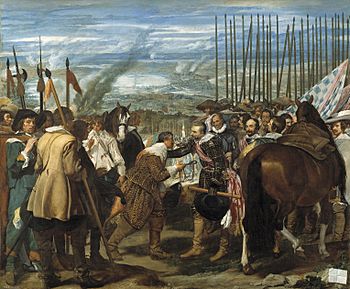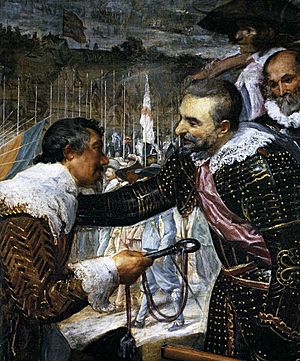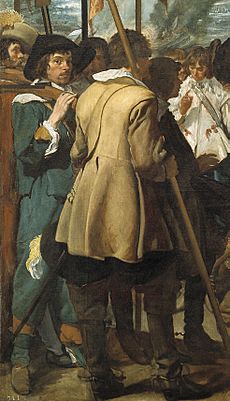The Surrender of Breda facts for kids
Quick facts for kids The Surrender of Breda |
|
|---|---|
| Spanish: La rendición de Breda, Las lanzas |
|
 |
|
| Artist | Diego Velázquez |
| Year | 1634–35 |
| Type | Oil on canvas |
| Dimensions | 307 cm × 367 cm (121 in × 144 in) |
| Location | Museo del Prado, Madrid, Spain |
La rendición de Breda (which means The Surrender of Breda in English) is a famous painting. It was created by the Spanish artist Diego Velázquez. People also call it Las lanzas (The Lances).
Velázquez finished this painting between 1634 and 1635. He was inspired after visiting Italy with Ambrogio Spinola. Spinola was a Spanish general from Genoa. He had won the city of Breda on June 5, 1625. The painting shows the Dutch giving the key of Breda to the Spanish.
Many people think this is one of Velázquez's best artworks. The painting shows the Dutch leader Justinus van Nassau and the Spanish general Spinola. Some say it is "one of the most Spanish of all pictures."
Contents
What's the Story Behind the Painting?
The Surrender of Breda shows a military victory. It's about the Siege of Breda in 1624. This event happened during the Eighty Years War. This war started when the Seventeen Provinces rebelled against Philip II of Spain. These provinces are now countries like the Netherlands, Belgium, and Luxembourg.
Velázquez painted the very end of the battle. He clearly showed the two sides: the Dutch and the Spanish. The painting makes the Spanish look very strong. But it also shows tired faces on both sides. This helps us see the real feelings of war.
Why Was This Painting Made?
Philip IV of Spain asked Velázquez to paint this artwork. It was made between 1630 and 1635. The painting was for the Buen Retiro palace in Madrid. Its main goal was to celebrate Spain's military wins. It also aimed to make King Philip IV feel proud. At that time, Spain was facing money problems.
The Surrender of Breda was displayed in a special room. This room was called the Hall of Realms. It was shown with nineteen other paintings. The Spanish minister, Gaspar de Guzmán, Count-Duke of Olivares, was in charge of decorating this hall. Velázquez was asked to paint horse riding scenes, a battle scene, and The Surrender of Breda. This painting became one of the most important works in the Hall of Realms. It is also considered one of Velázquez's greatest paintings.
What Does the Painting Show?
How the Painting is Arranged
Velázquez paid close attention to many details. He divided the painting into two main parts. The battle itself is happening in the background. The surrender part of the scene is in the front. The most important people are right in the middle.
The main focus is in the front of the painting. Here, the key is being handed over. In the background, you can see a smoky sky. This shows that there was destruction and fighting.
The painting shows many Spanish soldiers. There are fewer Dutch soldiers. The Dutch weapons look broken or thrown away. This suggests they lost the battle. On the other hand, the winning Spanish soldiers stand tall. They are surrounded by many upright lances on the right side.
A writer named José Ortega y Gasset said these lances were like "the backbone of the entire picture." He felt they made the lively scene feel calm. Velázquez used clever ways to show depth and light. These techniques make The Surrender of Breda one of his best works.
Colors Used in the Painting
The painting uses light and bright colors. This shows that Velázquez was influenced by paintings from Venice, Italy. He did not use strong reds or bright blues. Instead, he used calm brown colors. There are also dark shadows in the front of the painting.
Velázquez had traveled to Italy to study Renaissance art. Many believe his use of color is linked to this trip. While in Italy, he also improved his skills. He learned more about showing space, depth, and light.
Main Subject of the Painting
In the middle of the painting, you see Justinus van Nassau. He is giving the city's key to Spinola and Spain. Spinola was the general from Genoa. He led the Spanish soldiers, called tercios. These groups included soldiers with pikes, swords, and muskets. You can see them in the painting.
What Materials Were Used?
Experts studied the painting closely around 1989. This study happened at the Museo Prado. They found that Velázquez used many of the same colors he used in other paintings. These colors included lead white mixed with calcite. He also used azurite with a little charcoal black, ochre colors, and vermilion. The painting was made on a canvas that measures 307 cm by 367 cm.
Who Influenced Velázquez?
Some people think that Peter Paul Rubens inspired Velázquez. Rubens was another famous artist from the same time. Even though their styles were different, Rubens' earlier works might have influenced Velázquez. For example, Rubens' painting The Reconciliation of Esau and Jacob (1624) has a similar look and ideas.
More often, Velázquez's painting is linked to Rubens' Meeting of King Ferdinand of Hungary and Cardinal (1635). Both artists finished their works around the same time. So, it's possible they influenced each other. It's also likely they just created similar art because they were close friends. Velázquez's trip to Italy with Spinola also seems to have inspired his work.
Is the Painting Historically Accurate?
The painting shows the exchange of keys. This happened three days after Spain and the Netherlands signed an agreement. The agreement was signed on June 5, 1625. So, the painting is not about the battle itself. It's about the moment of peace and agreement.
At the very center of the painting, Justin of Nassau gives the key to Ambrogio Spinola. The painting is known for its calm and emotional feel. Velázquez chose not to show the blood and violence usually seen in battles.
One person who saw the event said: "Both [Spinola and Nassau] got off their horses. Spinola waited for Justin, surrounded by princes and high-ranking officers. The governor then came with his family and students. Spinola greeted and hugged his defeated opponent kindly. He also praised their bravery and long defense."
The Surrender of Breda shows the great respect Spinola had for the Dutch Army. Spinola had told his soldiers not to make fun of the Dutch. A report from that time says he even saluted Justin himself. The painting shows the human side of war. It praises Spinola's kindness towards Nassau and the Dutch Army.
Velázquez's friendship with Spinola makes The Surrender of Breda very accurate. The way Spinola is shown is definitely correct. Spinola's memories of the battle helped Velázquez paint it. Velázquez wanted to create a lasting tribute to Spinola. He wanted to show him as one of the most humane leaders of his time.
However, Velázquez did make one small mistake. He probably followed Spinola's description. He painted the Dutch Prince's Flag (Prinsenvlag) behind Justinus van Nassau's head. This flag is shown dipped to salute the Spanish winners. Velázquez painted it as a horizontal flag with blue, red, and white stripes. But in reality, the colors were orange, white, and blue. (Later, orange was replaced by red).
Images for kids
See also
 In Spanish: La rendición de Breda para niños
In Spanish: La rendición de Breda para niños








